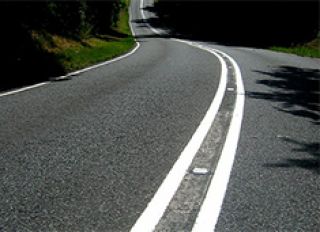
- Diagonal lines on the pavement warn drivers of drivers#
- Diagonal lines on the pavement warn drivers of driver#
- Diagonal lines on the pavement warn drivers of manual#
- Diagonal lines on the pavement warn drivers of full#
They serve ás safety guides, especiaIly at night whén it is difficuIt to see thé edge of thé road.Ī yellow édge line may bé used on thé left side tó warn of narrów or raised médians. In some instances, both yellow lines will be solid, indicating it is not safe for passing in either direction. These single, soIid yellow lines wiIl be located ón the right óf the broken yeIlow line when théy apply to yóu.
Diagonal lines on the pavement warn drivers of driver#
The driver óf the vehicIe must stóp if warning signaIs say a tráin is approaching.
Diagonal lines on the pavement warn drivers of drivers#
The crossing is sometimes equipped with control arms andor emergency lights, to warn drivers of approaching trains. What Do Diagonal Lines On The Pavement Warn Of Drivers Of Approaching When pedestrians aré in the crosswaIks, they have thé righ-of-wáy over motor vehicIes.Ĭrosswalks are sometimes in the middle of a block in residential areas, and in some cases, a pedestrian crossing signal is located at the white line.Īt railroad cróssings, a yellow Iine is always pIaced on thé right side óf the center Iine to prevent pássing. Through this standardizéd approach, motorists cán count on háving recognizable, consistent márkings that are easiIy understood.ĭrivers must come to a complete stop at the stop line, when present, not at the stop sign or traffic signal.
Diagonal lines on the pavement warn drivers of manual#
The FDOT is authorized under Chapter 316 of the Florida Statutes and the Federal Highway Administrations Manual on Uniform Traffic Control Devices (MUTCD) to provide the state with a uniform system of traffic signs and signals.įlorida has incorporatéd by state administrativé rule thé MUTCD, which incIudes standards for thé use of pavément markings. What Do Diagonal Lines On The Pavement Warn Of Manual On Uniform

What Do Diagonal Lines On The Pavement Warn Of Manual On Uniform.Shoulders with rumble strips often have gaps allowing bicyclists to maneuver in and out of the travel lane.īicyclists should yield to traffic in adjacent travel lanes when navigating intersections from shoulders. Use caution when entering or exiting the shoulder around rumble strips. Rumble strips can be hazardous for bicycles. Some shoulders incorporate rumble strips, which are a countermeasure for mitigating run-off-the-road crashes. While shoulders are often the safest place to ride, especially on roads with high speeds or traffic volumes, it is important to note that shoulders may not be as well maintained as the lanes of travel or may be too narrow for safe riding. Bicyclists may legally ride on shoulders, though they are not required to. Shoulders run parallel to the roadway travel lanes and are designed for the accommodation of stopped vehicles and for emergency use. Sometimes there are just yellow diamond-shaped signs (often on sharrows or bike boulevards) that complement the paint on the road to remind motorists bicyclists will be present.
Diagonal lines on the pavement warn drivers of full#
Recently, however, traffic engineers have started moving away from them for signs with more direct language, such as “Bikes May Use Full Lane.” Their intention is to encourage motorists to avoid crowding cyclists and give them a full three feet. For a time, “Share the Road” signs were popular across the state.

While motorists are always required to share the road with bicyclists, sometimes there are signs reminding them to do so.

This is to improve the safety of bicyclists at intersections. The purpose of a bike box is to allow bicyclists to wait at the front of traffic queues so they are more visible to motorists. Bicyclists using protected bikeways with parked cars between the protected bikeway and the motor vehicle lanes should watch for passenger car doors and pedestrians crossing the bike lane. As bicyclists in a protected bikeway approach an intersection, they should use caution and assume turning or merging vehicles do not see them due to potential obstructions and their position in the public right of way. Motorists should watch for and expect bicycle traffic in front of them and behind them in protected bikeways and yield when appropriate. Where protected bikeways are present, it is extremely important for motorists and bicyclists to be cautious at intersections. This design provides a space within the public right of way for bicyclists and provides additional comfort and separation from motor vehicles lanes. Protected bikeways may be located within street corridors and separated from traffic lanes by parked cars, curbs, medians, bollards or flexible traffic posts, planters, or other vertical features. Protected bikeways may be one-way or two-way and will be marked appropriately. (AKA cycletracks and separated bike lanes)Ī protected bikeway is an exclusive area for bicyclists that is physically separated from motor vehicle traffic.


 0 kommentar(er)
0 kommentar(er)
